An Analysis of the Internet of Things in Healthcare: A Report
VerifiedAdded on 2021/05/27
|15
|4970
|105
Report
AI Summary
This report provides an in-depth analysis of the application of the Internet of Things (IOT) in healthcare. It begins with an introduction to the problem domain, highlighting the challenges faced by traditional healthcare centers in managing patient records and providing timely treatment. The research aims to evaluate the efficiency of IOT in healthcare, focusing on the pros and cons of intelligent healthcare systems. The report explores the use of various IOT devices like video sensors, biometric sensors, and smart beds for remote patient monitoring, emphasizing the potential for instant medical facilities and improved patient outcomes. A detailed literature review is conducted to support the analysis. The report then discusses the advantages and disadvantages of IOT in healthcare, including its impact on patient care and the need for data confidentiality and scalability. The report also addresses the technological framework of IOT in healthcare, including wireless sensor networks, interoperability, and the accuracy of information. The report concludes by summarizing the key findings and implications of IOT in healthcare.
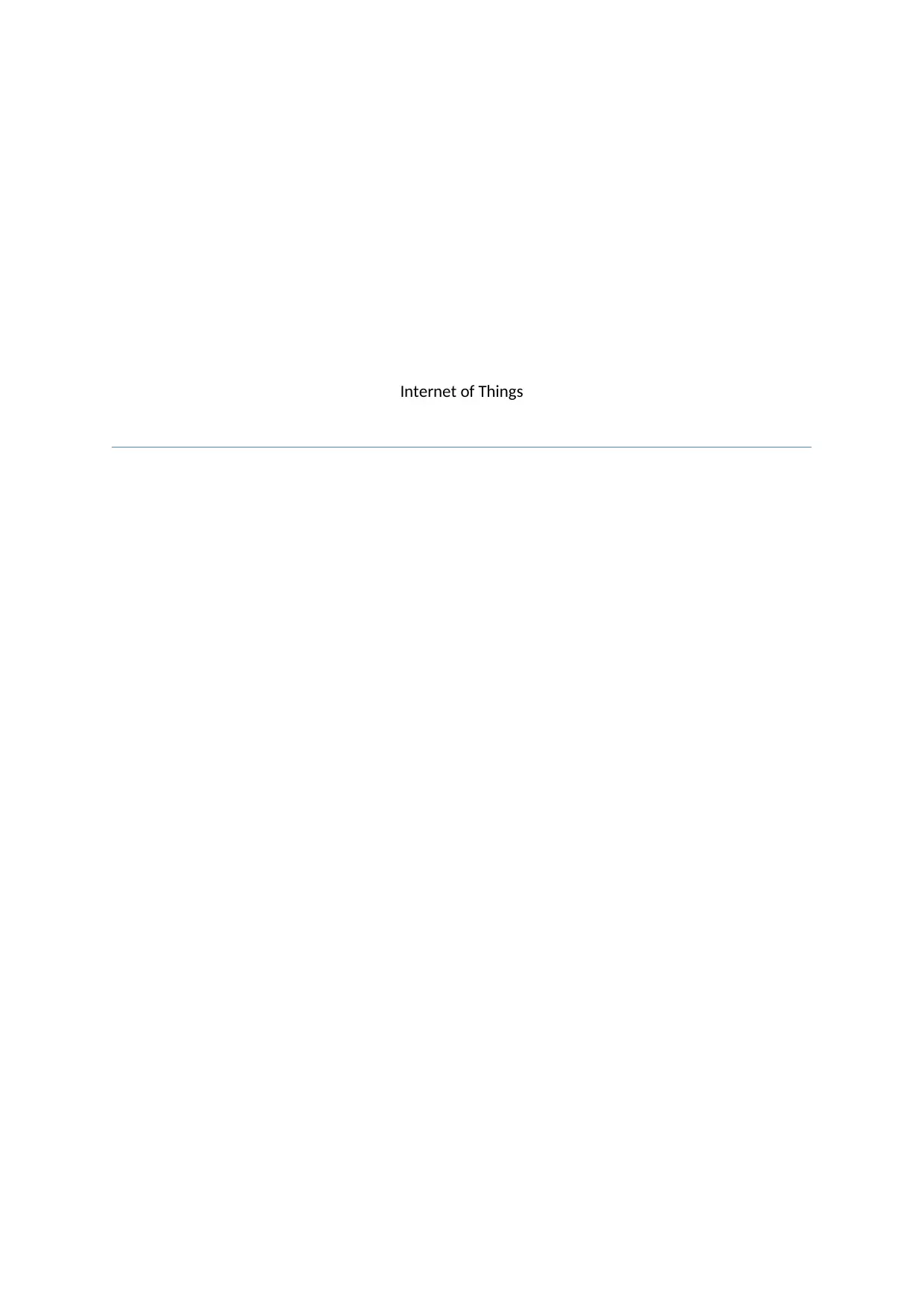
Internet of Things
Paraphrase This Document
Need a fresh take? Get an instant paraphrase of this document with our AI Paraphraser
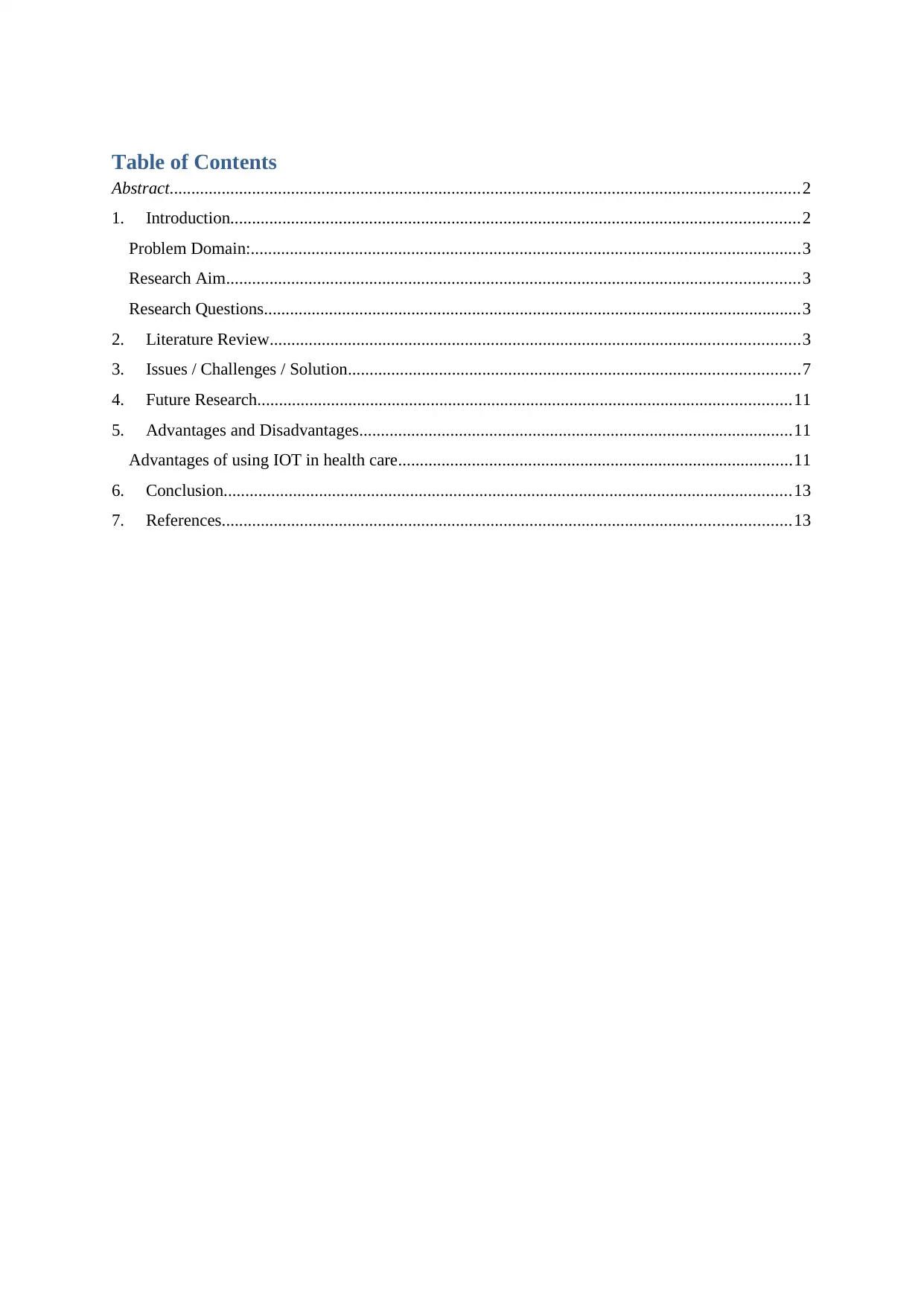
Table of Contents
Abstract.................................................................................................................................................2
1. Introduction...................................................................................................................................2
Problem Domain:...............................................................................................................................3
Research Aim....................................................................................................................................3
Research Questions............................................................................................................................3
2. Literature Review..........................................................................................................................3
3. Issues / Challenges / Solution........................................................................................................7
4. Future Research...........................................................................................................................11
5. Advantages and Disadvantages....................................................................................................11
Advantages of using IOT in health care...........................................................................................11
6. Conclusion...................................................................................................................................13
7. References...................................................................................................................................13
Abstract.................................................................................................................................................2
1. Introduction...................................................................................................................................2
Problem Domain:...............................................................................................................................3
Research Aim....................................................................................................................................3
Research Questions............................................................................................................................3
2. Literature Review..........................................................................................................................3
3. Issues / Challenges / Solution........................................................................................................7
4. Future Research...........................................................................................................................11
5. Advantages and Disadvantages....................................................................................................11
Advantages of using IOT in health care...........................................................................................11
6. Conclusion...................................................................................................................................13
7. References...................................................................................................................................13
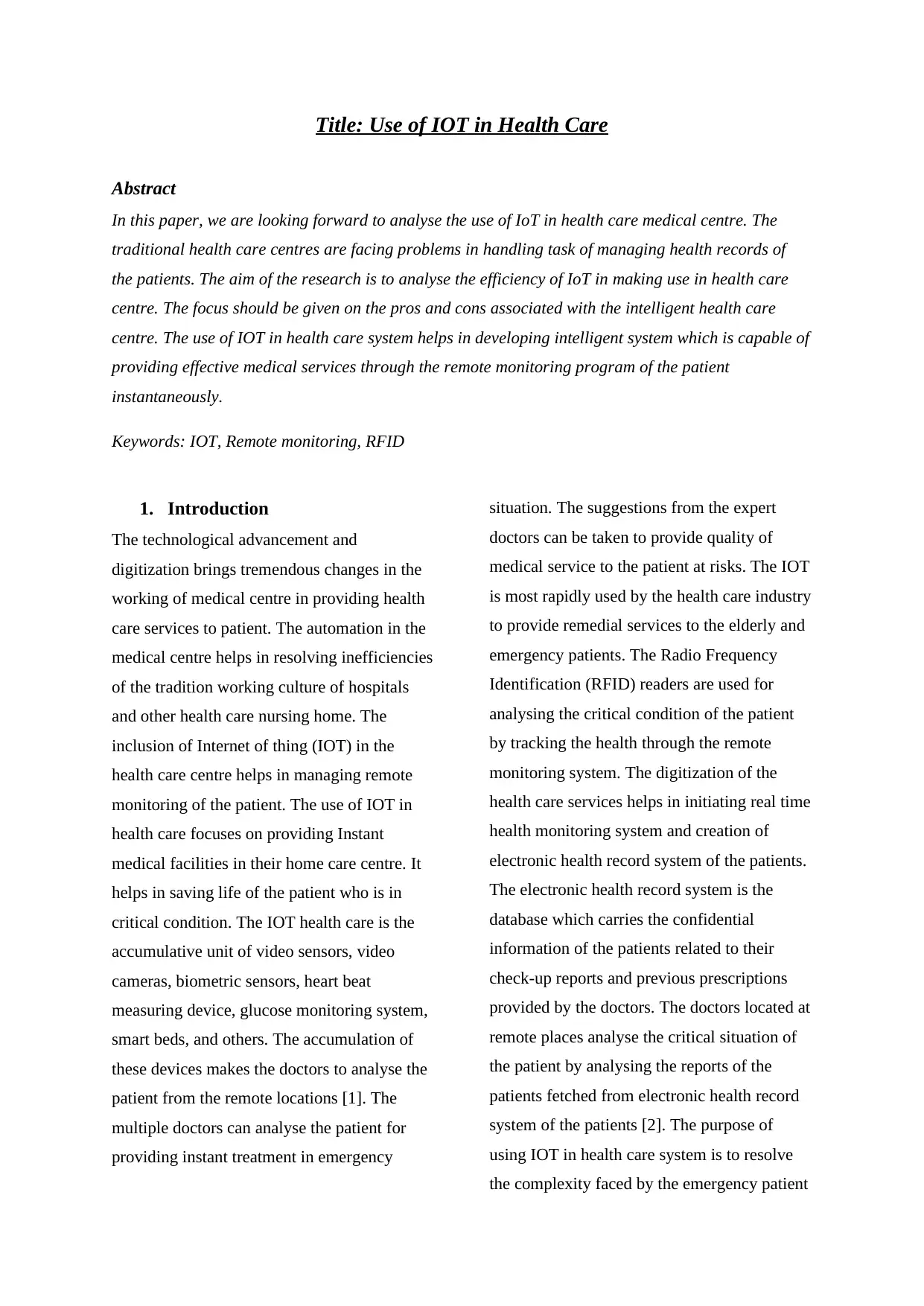
Title: Use of IOT in Health Care
Abstract
In this paper, we are looking forward to analyse the use of IoT in health care medical centre. The
traditional health care centres are facing problems in handling task of managing health records of
the patients. The aim of the research is to analyse the efficiency of IoT in making use in health care
centre. The focus should be given on the pros and cons associated with the intelligent health care
centre. The use of IOT in health care system helps in developing intelligent system which is capable of
providing effective medical services through the remote monitoring program of the patient
instantaneously.
Keywords: IOT, Remote monitoring, RFID
1. Introduction
The technological advancement and
digitization brings tremendous changes in the
working of medical centre in providing health
care services to patient. The automation in the
medical centre helps in resolving inefficiencies
of the tradition working culture of hospitals
and other health care nursing home. The
inclusion of Internet of thing (IOT) in the
health care centre helps in managing remote
monitoring of the patient. The use of IOT in
health care focuses on providing Instant
medical facilities in their home care centre. It
helps in saving life of the patient who is in
critical condition. The IOT health care is the
accumulative unit of video sensors, video
cameras, biometric sensors, heart beat
measuring device, glucose monitoring system,
smart beds, and others. The accumulation of
these devices makes the doctors to analyse the
patient from the remote locations [1]. The
multiple doctors can analyse the patient for
providing instant treatment in emergency
situation. The suggestions from the expert
doctors can be taken to provide quality of
medical service to the patient at risks. The IOT
is most rapidly used by the health care industry
to provide remedial services to the elderly and
emergency patients. The Radio Frequency
Identification (RFID) readers are used for
analysing the critical condition of the patient
by tracking the health through the remote
monitoring system. The digitization of the
health care services helps in initiating real time
health monitoring system and creation of
electronic health record system of the patients.
The electronic health record system is the
database which carries the confidential
information of the patients related to their
check-up reports and previous prescriptions
provided by the doctors. The doctors located at
remote places analyse the critical situation of
the patient by analysing the reports of the
patients fetched from electronic health record
system of the patients [2]. The purpose of
using IOT in health care system is to resolve
the complexity faced by the emergency patient
Abstract
In this paper, we are looking forward to analyse the use of IoT in health care medical centre. The
traditional health care centres are facing problems in handling task of managing health records of
the patients. The aim of the research is to analyse the efficiency of IoT in making use in health care
centre. The focus should be given on the pros and cons associated with the intelligent health care
centre. The use of IOT in health care system helps in developing intelligent system which is capable of
providing effective medical services through the remote monitoring program of the patient
instantaneously.
Keywords: IOT, Remote monitoring, RFID
1. Introduction
The technological advancement and
digitization brings tremendous changes in the
working of medical centre in providing health
care services to patient. The automation in the
medical centre helps in resolving inefficiencies
of the tradition working culture of hospitals
and other health care nursing home. The
inclusion of Internet of thing (IOT) in the
health care centre helps in managing remote
monitoring of the patient. The use of IOT in
health care focuses on providing Instant
medical facilities in their home care centre. It
helps in saving life of the patient who is in
critical condition. The IOT health care is the
accumulative unit of video sensors, video
cameras, biometric sensors, heart beat
measuring device, glucose monitoring system,
smart beds, and others. The accumulation of
these devices makes the doctors to analyse the
patient from the remote locations [1]. The
multiple doctors can analyse the patient for
providing instant treatment in emergency
situation. The suggestions from the expert
doctors can be taken to provide quality of
medical service to the patient at risks. The IOT
is most rapidly used by the health care industry
to provide remedial services to the elderly and
emergency patients. The Radio Frequency
Identification (RFID) readers are used for
analysing the critical condition of the patient
by tracking the health through the remote
monitoring system. The digitization of the
health care services helps in initiating real time
health monitoring system and creation of
electronic health record system of the patients.
The electronic health record system is the
database which carries the confidential
information of the patients related to their
check-up reports and previous prescriptions
provided by the doctors. The doctors located at
remote places analyse the critical situation of
the patient by analysing the reports of the
patients fetched from electronic health record
system of the patients [2]. The purpose of
using IOT in health care system is to resolve
the complexity faced by the emergency patient
⊘ This is a preview!⊘
Do you want full access?
Subscribe today to unlock all pages.

Trusted by 1+ million students worldwide
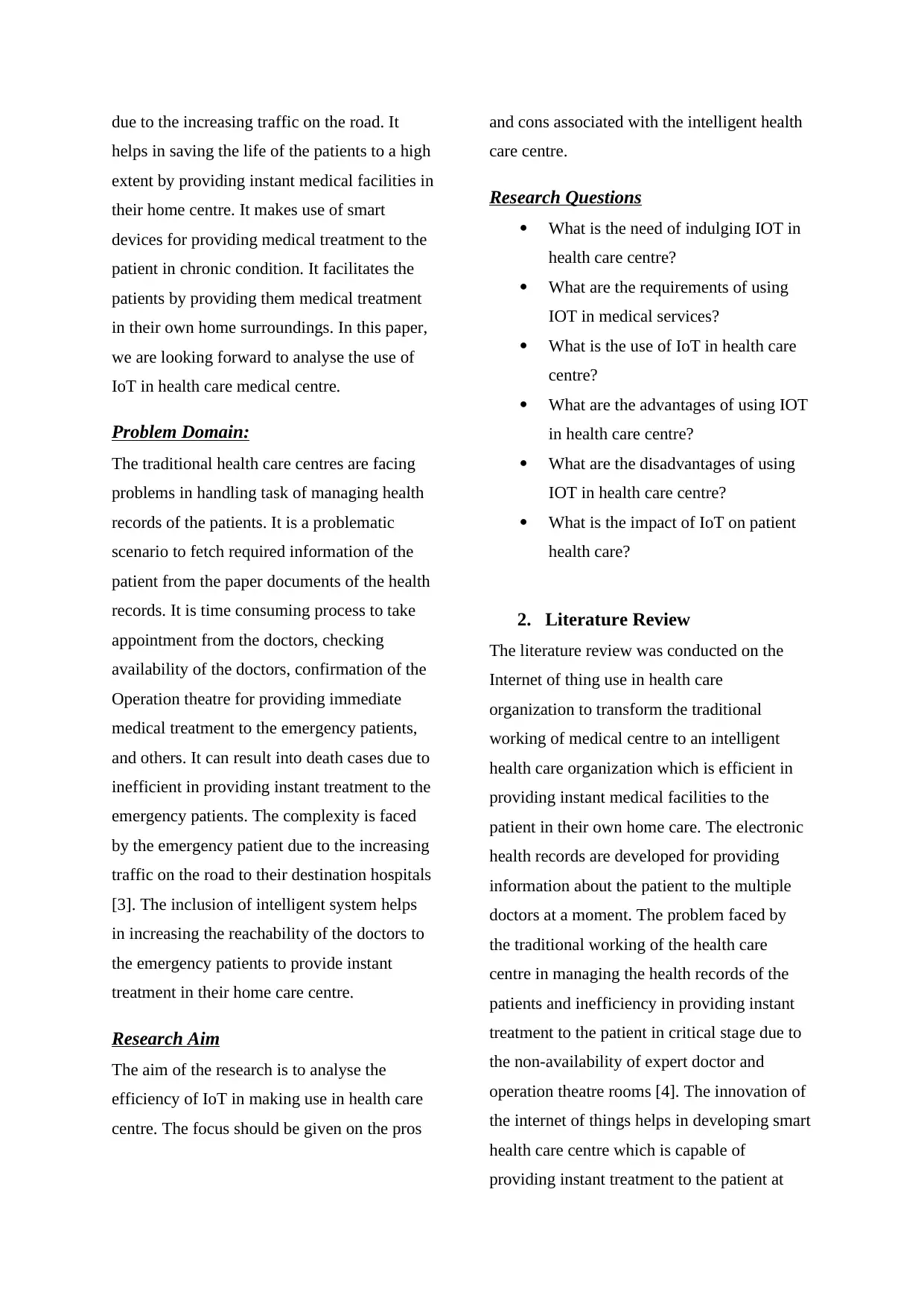
due to the increasing traffic on the road. It
helps in saving the life of the patients to a high
extent by providing instant medical facilities in
their home centre. It makes use of smart
devices for providing medical treatment to the
patient in chronic condition. It facilitates the
patients by providing them medical treatment
in their own home surroundings. In this paper,
we are looking forward to analyse the use of
IoT in health care medical centre.
Problem Domain:
The traditional health care centres are facing
problems in handling task of managing health
records of the patients. It is a problematic
scenario to fetch required information of the
patient from the paper documents of the health
records. It is time consuming process to take
appointment from the doctors, checking
availability of the doctors, confirmation of the
Operation theatre for providing immediate
medical treatment to the emergency patients,
and others. It can result into death cases due to
inefficient in providing instant treatment to the
emergency patients. The complexity is faced
by the emergency patient due to the increasing
traffic on the road to their destination hospitals
[3]. The inclusion of intelligent system helps
in increasing the reachability of the doctors to
the emergency patients to provide instant
treatment in their home care centre.
Research Aim
The aim of the research is to analyse the
efficiency of IoT in making use in health care
centre. The focus should be given on the pros
and cons associated with the intelligent health
care centre.
Research Questions
What is the need of indulging IOT in
health care centre?
What are the requirements of using
IOT in medical services?
What is the use of IoT in health care
centre?
What are the advantages of using IOT
in health care centre?
What are the disadvantages of using
IOT in health care centre?
What is the impact of IoT on patient
health care?
2. Literature Review
The literature review was conducted on the
Internet of thing use in health care
organization to transform the traditional
working of medical centre to an intelligent
health care organization which is efficient in
providing instant medical facilities to the
patient in their own home care. The electronic
health records are developed for providing
information about the patient to the multiple
doctors at a moment. The problem faced by
the traditional working of the health care
centre in managing the health records of the
patients and inefficiency in providing instant
treatment to the patient in critical stage due to
the non-availability of expert doctor and
operation theatre rooms [4]. The innovation of
the internet of things helps in developing smart
health care centre which is capable of
providing instant treatment to the patient at
helps in saving the life of the patients to a high
extent by providing instant medical facilities in
their home centre. It makes use of smart
devices for providing medical treatment to the
patient in chronic condition. It facilitates the
patients by providing them medical treatment
in their own home surroundings. In this paper,
we are looking forward to analyse the use of
IoT in health care medical centre.
Problem Domain:
The traditional health care centres are facing
problems in handling task of managing health
records of the patients. It is a problematic
scenario to fetch required information of the
patient from the paper documents of the health
records. It is time consuming process to take
appointment from the doctors, checking
availability of the doctors, confirmation of the
Operation theatre for providing immediate
medical treatment to the emergency patients,
and others. It can result into death cases due to
inefficient in providing instant treatment to the
emergency patients. The complexity is faced
by the emergency patient due to the increasing
traffic on the road to their destination hospitals
[3]. The inclusion of intelligent system helps
in increasing the reachability of the doctors to
the emergency patients to provide instant
treatment in their home care centre.
Research Aim
The aim of the research is to analyse the
efficiency of IoT in making use in health care
centre. The focus should be given on the pros
and cons associated with the intelligent health
care centre.
Research Questions
What is the need of indulging IOT in
health care centre?
What are the requirements of using
IOT in medical services?
What is the use of IoT in health care
centre?
What are the advantages of using IOT
in health care centre?
What are the disadvantages of using
IOT in health care centre?
What is the impact of IoT on patient
health care?
2. Literature Review
The literature review was conducted on the
Internet of thing use in health care
organization to transform the traditional
working of medical centre to an intelligent
health care organization which is efficient in
providing instant medical facilities to the
patient in their own home care. The electronic
health records are developed for providing
information about the patient to the multiple
doctors at a moment. The problem faced by
the traditional working of the health care
centre in managing the health records of the
patients and inefficiency in providing instant
treatment to the patient in critical stage due to
the non-availability of expert doctor and
operation theatre rooms [4]. The innovation of
the internet of things helps in developing smart
health care centre which is capable of
providing instant treatment to the patient at
Paraphrase This Document
Need a fresh take? Get an instant paraphrase of this document with our AI Paraphraser
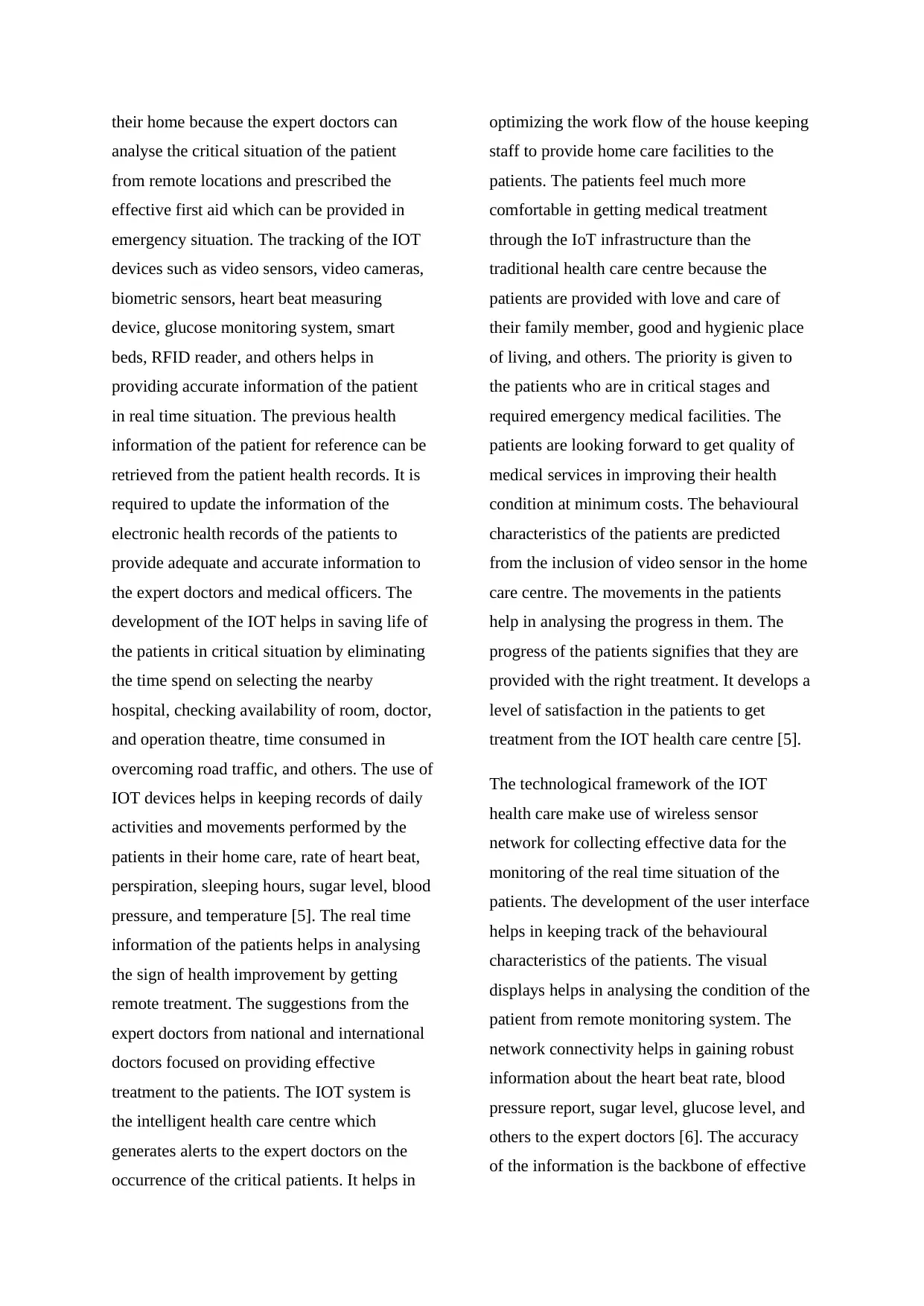
their home because the expert doctors can
analyse the critical situation of the patient
from remote locations and prescribed the
effective first aid which can be provided in
emergency situation. The tracking of the IOT
devices such as video sensors, video cameras,
biometric sensors, heart beat measuring
device, glucose monitoring system, smart
beds, RFID reader, and others helps in
providing accurate information of the patient
in real time situation. The previous health
information of the patient for reference can be
retrieved from the patient health records. It is
required to update the information of the
electronic health records of the patients to
provide adequate and accurate information to
the expert doctors and medical officers. The
development of the IOT helps in saving life of
the patients in critical situation by eliminating
the time spend on selecting the nearby
hospital, checking availability of room, doctor,
and operation theatre, time consumed in
overcoming road traffic, and others. The use of
IOT devices helps in keeping records of daily
activities and movements performed by the
patients in their home care, rate of heart beat,
perspiration, sleeping hours, sugar level, blood
pressure, and temperature [5]. The real time
information of the patients helps in analysing
the sign of health improvement by getting
remote treatment. The suggestions from the
expert doctors from national and international
doctors focused on providing effective
treatment to the patients. The IOT system is
the intelligent health care centre which
generates alerts to the expert doctors on the
occurrence of the critical patients. It helps in
optimizing the work flow of the house keeping
staff to provide home care facilities to the
patients. The patients feel much more
comfortable in getting medical treatment
through the IoT infrastructure than the
traditional health care centre because the
patients are provided with love and care of
their family member, good and hygienic place
of living, and others. The priority is given to
the patients who are in critical stages and
required emergency medical facilities. The
patients are looking forward to get quality of
medical services in improving their health
condition at minimum costs. The behavioural
characteristics of the patients are predicted
from the inclusion of video sensor in the home
care centre. The movements in the patients
help in analysing the progress in them. The
progress of the patients signifies that they are
provided with the right treatment. It develops a
level of satisfaction in the patients to get
treatment from the IOT health care centre [5].
The technological framework of the IOT
health care make use of wireless sensor
network for collecting effective data for the
monitoring of the real time situation of the
patients. The development of the user interface
helps in keeping track of the behavioural
characteristics of the patients. The visual
displays helps in analysing the condition of the
patient from remote monitoring system. The
network connectivity helps in gaining robust
information about the heart beat rate, blood
pressure report, sugar level, glucose level, and
others to the expert doctors [6]. The accuracy
of the information is the backbone of effective
analyse the critical situation of the patient
from remote locations and prescribed the
effective first aid which can be provided in
emergency situation. The tracking of the IOT
devices such as video sensors, video cameras,
biometric sensors, heart beat measuring
device, glucose monitoring system, smart
beds, RFID reader, and others helps in
providing accurate information of the patient
in real time situation. The previous health
information of the patient for reference can be
retrieved from the patient health records. It is
required to update the information of the
electronic health records of the patients to
provide adequate and accurate information to
the expert doctors and medical officers. The
development of the IOT helps in saving life of
the patients in critical situation by eliminating
the time spend on selecting the nearby
hospital, checking availability of room, doctor,
and operation theatre, time consumed in
overcoming road traffic, and others. The use of
IOT devices helps in keeping records of daily
activities and movements performed by the
patients in their home care, rate of heart beat,
perspiration, sleeping hours, sugar level, blood
pressure, and temperature [5]. The real time
information of the patients helps in analysing
the sign of health improvement by getting
remote treatment. The suggestions from the
expert doctors from national and international
doctors focused on providing effective
treatment to the patients. The IOT system is
the intelligent health care centre which
generates alerts to the expert doctors on the
occurrence of the critical patients. It helps in
optimizing the work flow of the house keeping
staff to provide home care facilities to the
patients. The patients feel much more
comfortable in getting medical treatment
through the IoT infrastructure than the
traditional health care centre because the
patients are provided with love and care of
their family member, good and hygienic place
of living, and others. The priority is given to
the patients who are in critical stages and
required emergency medical facilities. The
patients are looking forward to get quality of
medical services in improving their health
condition at minimum costs. The behavioural
characteristics of the patients are predicted
from the inclusion of video sensor in the home
care centre. The movements in the patients
help in analysing the progress in them. The
progress of the patients signifies that they are
provided with the right treatment. It develops a
level of satisfaction in the patients to get
treatment from the IOT health care centre [5].
The technological framework of the IOT
health care make use of wireless sensor
network for collecting effective data for the
monitoring of the real time situation of the
patients. The development of the user interface
helps in keeping track of the behavioural
characteristics of the patients. The visual
displays helps in analysing the condition of the
patient from remote monitoring system. The
network connectivity helps in gaining robust
information about the heart beat rate, blood
pressure report, sugar level, glucose level, and
others to the expert doctors [6]. The accuracy
of the information is the backbone of effective
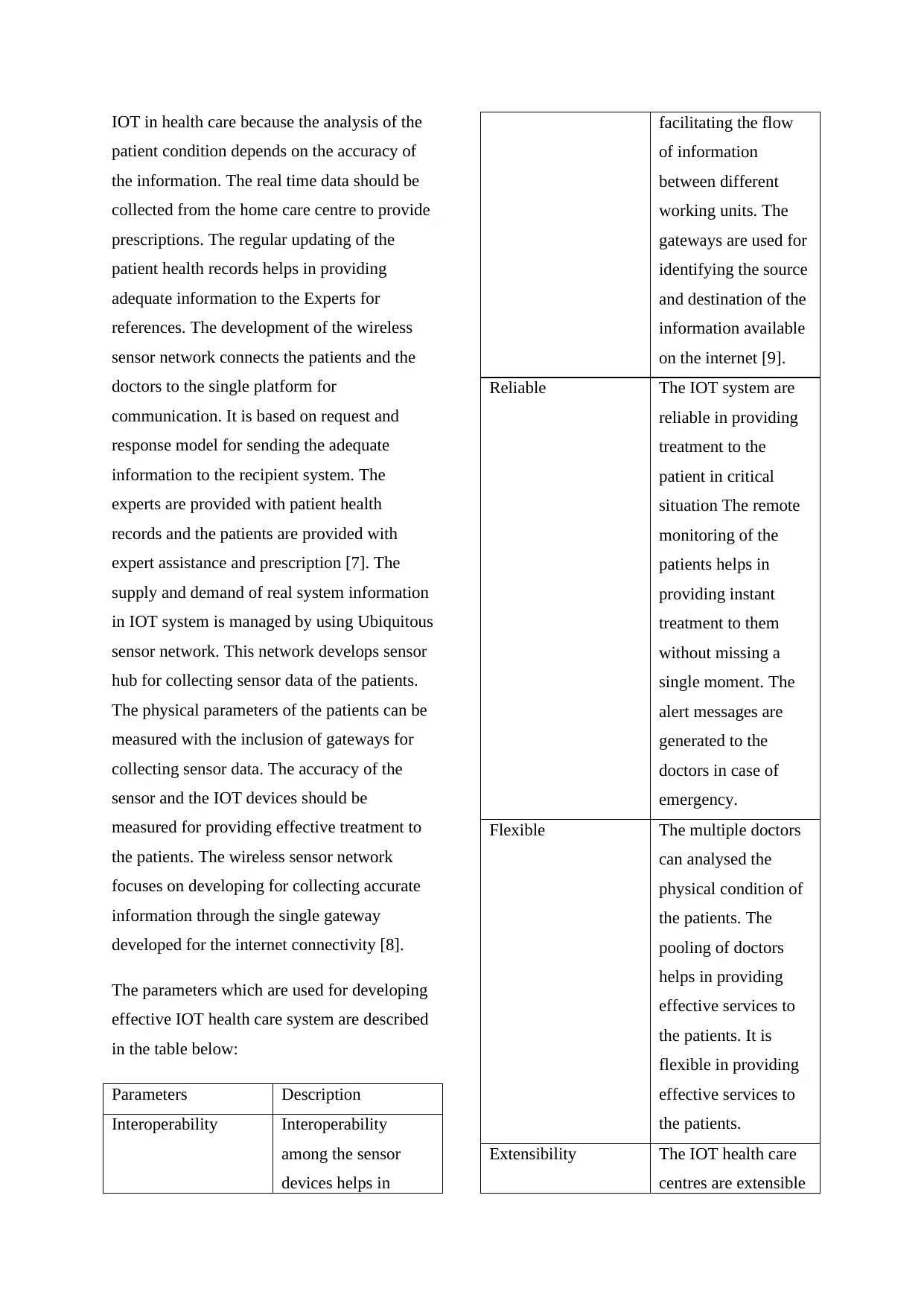
IOT in health care because the analysis of the
patient condition depends on the accuracy of
the information. The real time data should be
collected from the home care centre to provide
prescriptions. The regular updating of the
patient health records helps in providing
adequate information to the Experts for
references. The development of the wireless
sensor network connects the patients and the
doctors to the single platform for
communication. It is based on request and
response model for sending the adequate
information to the recipient system. The
experts are provided with patient health
records and the patients are provided with
expert assistance and prescription [7]. The
supply and demand of real system information
in IOT system is managed by using Ubiquitous
sensor network. This network develops sensor
hub for collecting sensor data of the patients.
The physical parameters of the patients can be
measured with the inclusion of gateways for
collecting sensor data. The accuracy of the
sensor and the IOT devices should be
measured for providing effective treatment to
the patients. The wireless sensor network
focuses on developing for collecting accurate
information through the single gateway
developed for the internet connectivity [8].
The parameters which are used for developing
effective IOT health care system are described
in the table below:
Parameters Description
Interoperability Interoperability
among the sensor
devices helps in
facilitating the flow
of information
between different
working units. The
gateways are used for
identifying the source
and destination of the
information available
on the internet [9].
Reliable The IOT system are
reliable in providing
treatment to the
patient in critical
situation The remote
monitoring of the
patients helps in
providing instant
treatment to them
without missing a
single moment. The
alert messages are
generated to the
doctors in case of
emergency.
Flexible The multiple doctors
can analysed the
physical condition of
the patients. The
pooling of doctors
helps in providing
effective services to
the patients. It is
flexible in providing
effective services to
the patients.
Extensibility The IOT health care
centres are extensible
patient condition depends on the accuracy of
the information. The real time data should be
collected from the home care centre to provide
prescriptions. The regular updating of the
patient health records helps in providing
adequate information to the Experts for
references. The development of the wireless
sensor network connects the patients and the
doctors to the single platform for
communication. It is based on request and
response model for sending the adequate
information to the recipient system. The
experts are provided with patient health
records and the patients are provided with
expert assistance and prescription [7]. The
supply and demand of real system information
in IOT system is managed by using Ubiquitous
sensor network. This network develops sensor
hub for collecting sensor data of the patients.
The physical parameters of the patients can be
measured with the inclusion of gateways for
collecting sensor data. The accuracy of the
sensor and the IOT devices should be
measured for providing effective treatment to
the patients. The wireless sensor network
focuses on developing for collecting accurate
information through the single gateway
developed for the internet connectivity [8].
The parameters which are used for developing
effective IOT health care system are described
in the table below:
Parameters Description
Interoperability Interoperability
among the sensor
devices helps in
facilitating the flow
of information
between different
working units. The
gateways are used for
identifying the source
and destination of the
information available
on the internet [9].
Reliable The IOT system are
reliable in providing
treatment to the
patient in critical
situation The remote
monitoring of the
patients helps in
providing instant
treatment to them
without missing a
single moment. The
alert messages are
generated to the
doctors in case of
emergency.
Flexible The multiple doctors
can analysed the
physical condition of
the patients. The
pooling of doctors
helps in providing
effective services to
the patients. It is
flexible in providing
effective services to
the patients.
Extensibility The IOT health care
centres are extensible
⊘ This is a preview!⊘
Do you want full access?
Subscribe today to unlock all pages.

Trusted by 1+ million students worldwide
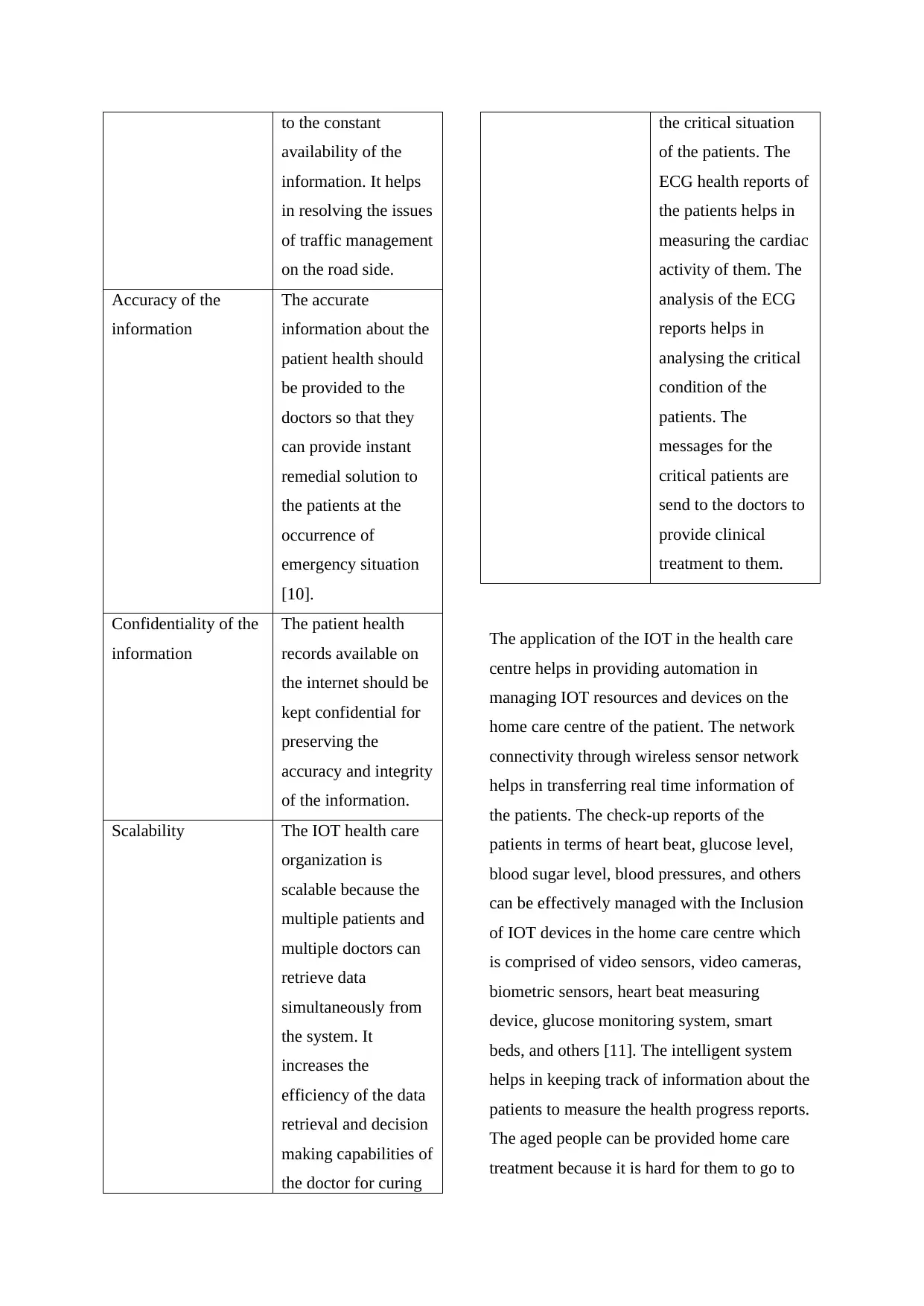
to the constant
availability of the
information. It helps
in resolving the issues
of traffic management
on the road side.
Accuracy of the
information
The accurate
information about the
patient health should
be provided to the
doctors so that they
can provide instant
remedial solution to
the patients at the
occurrence of
emergency situation
[10].
Confidentiality of the
information
The patient health
records available on
the internet should be
kept confidential for
preserving the
accuracy and integrity
of the information.
Scalability The IOT health care
organization is
scalable because the
multiple patients and
multiple doctors can
retrieve data
simultaneously from
the system. It
increases the
efficiency of the data
retrieval and decision
making capabilities of
the doctor for curing
the critical situation
of the patients. The
ECG health reports of
the patients helps in
measuring the cardiac
activity of them. The
analysis of the ECG
reports helps in
analysing the critical
condition of the
patients. The
messages for the
critical patients are
send to the doctors to
provide clinical
treatment to them.
The application of the IOT in the health care
centre helps in providing automation in
managing IOT resources and devices on the
home care centre of the patient. The network
connectivity through wireless sensor network
helps in transferring real time information of
the patients. The check-up reports of the
patients in terms of heart beat, glucose level,
blood sugar level, blood pressures, and others
can be effectively managed with the Inclusion
of IOT devices in the home care centre which
is comprised of video sensors, video cameras,
biometric sensors, heart beat measuring
device, glucose monitoring system, smart
beds, and others [11]. The intelligent system
helps in keeping track of information about the
patients to measure the health progress reports.
The aged people can be provided home care
treatment because it is hard for them to go to
availability of the
information. It helps
in resolving the issues
of traffic management
on the road side.
Accuracy of the
information
The accurate
information about the
patient health should
be provided to the
doctors so that they
can provide instant
remedial solution to
the patients at the
occurrence of
emergency situation
[10].
Confidentiality of the
information
The patient health
records available on
the internet should be
kept confidential for
preserving the
accuracy and integrity
of the information.
Scalability The IOT health care
organization is
scalable because the
multiple patients and
multiple doctors can
retrieve data
simultaneously from
the system. It
increases the
efficiency of the data
retrieval and decision
making capabilities of
the doctor for curing
the critical situation
of the patients. The
ECG health reports of
the patients helps in
measuring the cardiac
activity of them. The
analysis of the ECG
reports helps in
analysing the critical
condition of the
patients. The
messages for the
critical patients are
send to the doctors to
provide clinical
treatment to them.
The application of the IOT in the health care
centre helps in providing automation in
managing IOT resources and devices on the
home care centre of the patient. The network
connectivity through wireless sensor network
helps in transferring real time information of
the patients. The check-up reports of the
patients in terms of heart beat, glucose level,
blood sugar level, blood pressures, and others
can be effectively managed with the Inclusion
of IOT devices in the home care centre which
is comprised of video sensors, video cameras,
biometric sensors, heart beat measuring
device, glucose monitoring system, smart
beds, and others [11]. The intelligent system
helps in keeping track of information about the
patients to measure the health progress reports.
The aged people can be provided home care
treatment because it is hard for them to go to
Paraphrase This Document
Need a fresh take? Get an instant paraphrase of this document with our AI Paraphraser
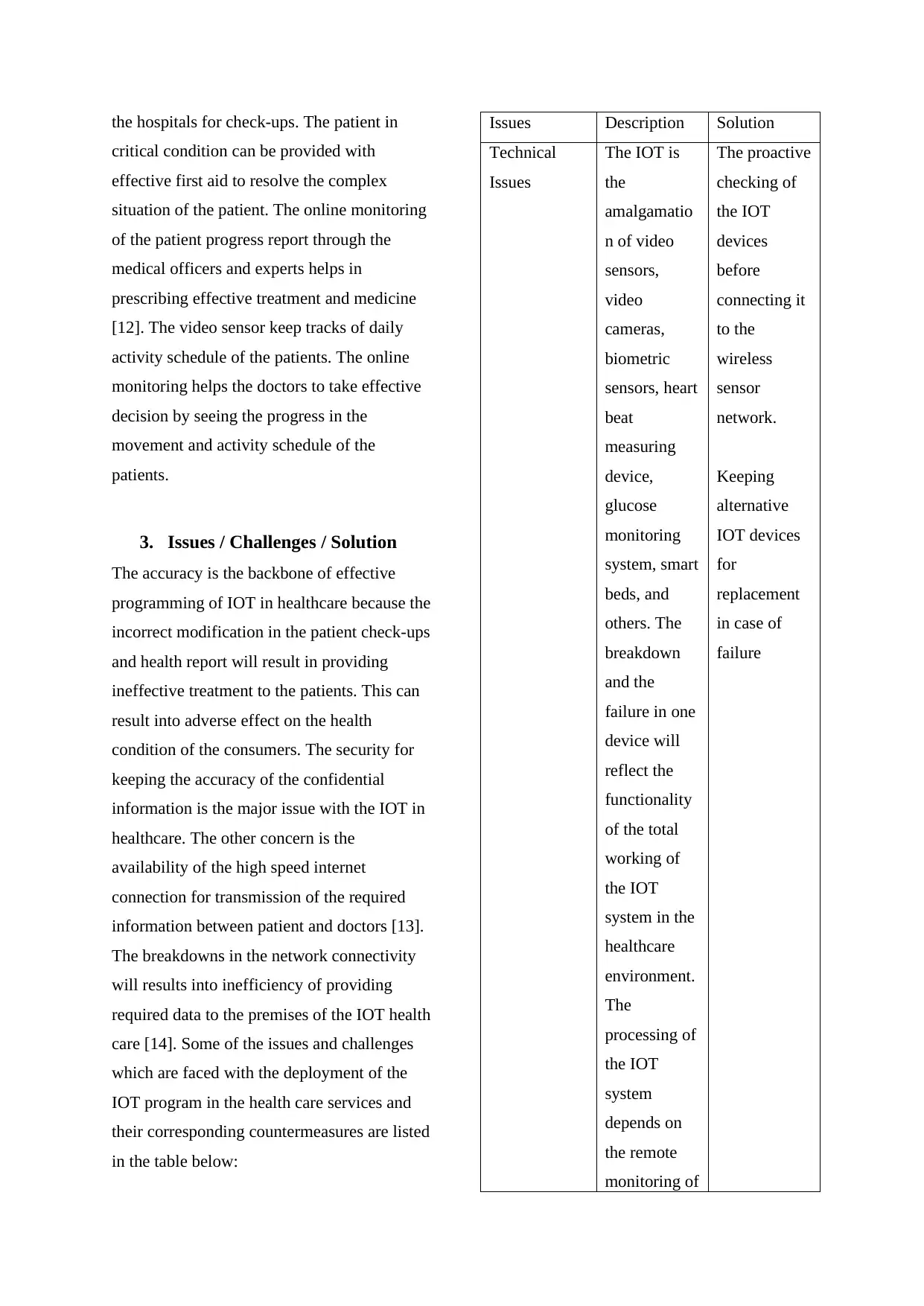
the hospitals for check-ups. The patient in
critical condition can be provided with
effective first aid to resolve the complex
situation of the patient. The online monitoring
of the patient progress report through the
medical officers and experts helps in
prescribing effective treatment and medicine
[12]. The video sensor keep tracks of daily
activity schedule of the patients. The online
monitoring helps the doctors to take effective
decision by seeing the progress in the
movement and activity schedule of the
patients.
3. Issues / Challenges / Solution
The accuracy is the backbone of effective
programming of IOT in healthcare because the
incorrect modification in the patient check-ups
and health report will result in providing
ineffective treatment to the patients. This can
result into adverse effect on the health
condition of the consumers. The security for
keeping the accuracy of the confidential
information is the major issue with the IOT in
healthcare. The other concern is the
availability of the high speed internet
connection for transmission of the required
information between patient and doctors [13].
The breakdowns in the network connectivity
will results into inefficiency of providing
required data to the premises of the IOT health
care [14]. Some of the issues and challenges
which are faced with the deployment of the
IOT program in the health care services and
their corresponding countermeasures are listed
in the table below:
Issues Description Solution
Technical
Issues
The IOT is
the
amalgamatio
n of video
sensors,
video
cameras,
biometric
sensors, heart
beat
measuring
device,
glucose
monitoring
system, smart
beds, and
others. The
breakdown
and the
failure in one
device will
reflect the
functionality
of the total
working of
the IOT
system in the
healthcare
environment.
The
processing of
the IOT
system
depends on
the remote
monitoring of
The proactive
checking of
the IOT
devices
before
connecting it
to the
wireless
sensor
network.
Keeping
alternative
IOT devices
for
replacement
in case of
failure
critical condition can be provided with
effective first aid to resolve the complex
situation of the patient. The online monitoring
of the patient progress report through the
medical officers and experts helps in
prescribing effective treatment and medicine
[12]. The video sensor keep tracks of daily
activity schedule of the patients. The online
monitoring helps the doctors to take effective
decision by seeing the progress in the
movement and activity schedule of the
patients.
3. Issues / Challenges / Solution
The accuracy is the backbone of effective
programming of IOT in healthcare because the
incorrect modification in the patient check-ups
and health report will result in providing
ineffective treatment to the patients. This can
result into adverse effect on the health
condition of the consumers. The security for
keeping the accuracy of the confidential
information is the major issue with the IOT in
healthcare. The other concern is the
availability of the high speed internet
connection for transmission of the required
information between patient and doctors [13].
The breakdowns in the network connectivity
will results into inefficiency of providing
required data to the premises of the IOT health
care [14]. Some of the issues and challenges
which are faced with the deployment of the
IOT program in the health care services and
their corresponding countermeasures are listed
in the table below:
Issues Description Solution
Technical
Issues
The IOT is
the
amalgamatio
n of video
sensors,
video
cameras,
biometric
sensors, heart
beat
measuring
device,
glucose
monitoring
system, smart
beds, and
others. The
breakdown
and the
failure in one
device will
reflect the
functionality
of the total
working of
the IOT
system in the
healthcare
environment.
The
processing of
the IOT
system
depends on
the remote
monitoring of
The proactive
checking of
the IOT
devices
before
connecting it
to the
wireless
sensor
network.
Keeping
alternative
IOT devices
for
replacement
in case of
failure
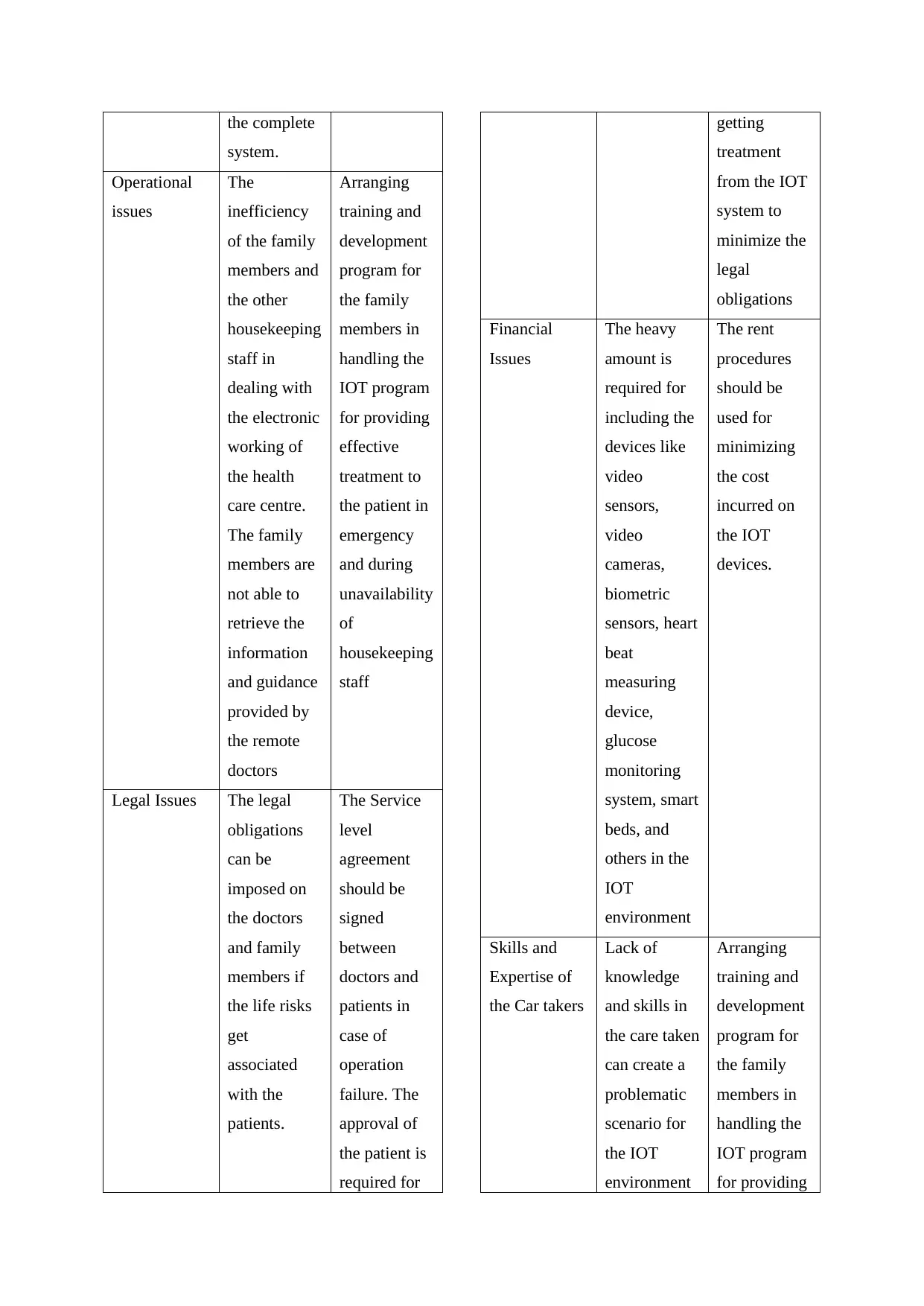
the complete
system.
Operational
issues
The
inefficiency
of the family
members and
the other
housekeeping
staff in
dealing with
the electronic
working of
the health
care centre.
The family
members are
not able to
retrieve the
information
and guidance
provided by
the remote
doctors
Arranging
training and
development
program for
the family
members in
handling the
IOT program
for providing
effective
treatment to
the patient in
emergency
and during
unavailability
of
housekeeping
staff
Legal Issues The legal
obligations
can be
imposed on
the doctors
and family
members if
the life risks
get
associated
with the
patients.
The Service
level
agreement
should be
signed
between
doctors and
patients in
case of
operation
failure. The
approval of
the patient is
required for
getting
treatment
from the IOT
system to
minimize the
legal
obligations
Financial
Issues
The heavy
amount is
required for
including the
devices like
video
sensors,
video
cameras,
biometric
sensors, heart
beat
measuring
device,
glucose
monitoring
system, smart
beds, and
others in the
IOT
environment
The rent
procedures
should be
used for
minimizing
the cost
incurred on
the IOT
devices.
Skills and
Expertise of
the Car takers
Lack of
knowledge
and skills in
the care taken
can create a
problematic
scenario for
the IOT
environment
Arranging
training and
development
program for
the family
members in
handling the
IOT program
for providing
system.
Operational
issues
The
inefficiency
of the family
members and
the other
housekeeping
staff in
dealing with
the electronic
working of
the health
care centre.
The family
members are
not able to
retrieve the
information
and guidance
provided by
the remote
doctors
Arranging
training and
development
program for
the family
members in
handling the
IOT program
for providing
effective
treatment to
the patient in
emergency
and during
unavailability
of
housekeeping
staff
Legal Issues The legal
obligations
can be
imposed on
the doctors
and family
members if
the life risks
get
associated
with the
patients.
The Service
level
agreement
should be
signed
between
doctors and
patients in
case of
operation
failure. The
approval of
the patient is
required for
getting
treatment
from the IOT
system to
minimize the
legal
obligations
Financial
Issues
The heavy
amount is
required for
including the
devices like
video
sensors,
video
cameras,
biometric
sensors, heart
beat
measuring
device,
glucose
monitoring
system, smart
beds, and
others in the
IOT
environment
The rent
procedures
should be
used for
minimizing
the cost
incurred on
the IOT
devices.
Skills and
Expertise of
the Car takers
Lack of
knowledge
and skills in
the care taken
can create a
problematic
scenario for
the IOT
environment
Arranging
training and
development
program for
the family
members in
handling the
IOT program
for providing
⊘ This is a preview!⊘
Do you want full access?
Subscribe today to unlock all pages.

Trusted by 1+ million students worldwide
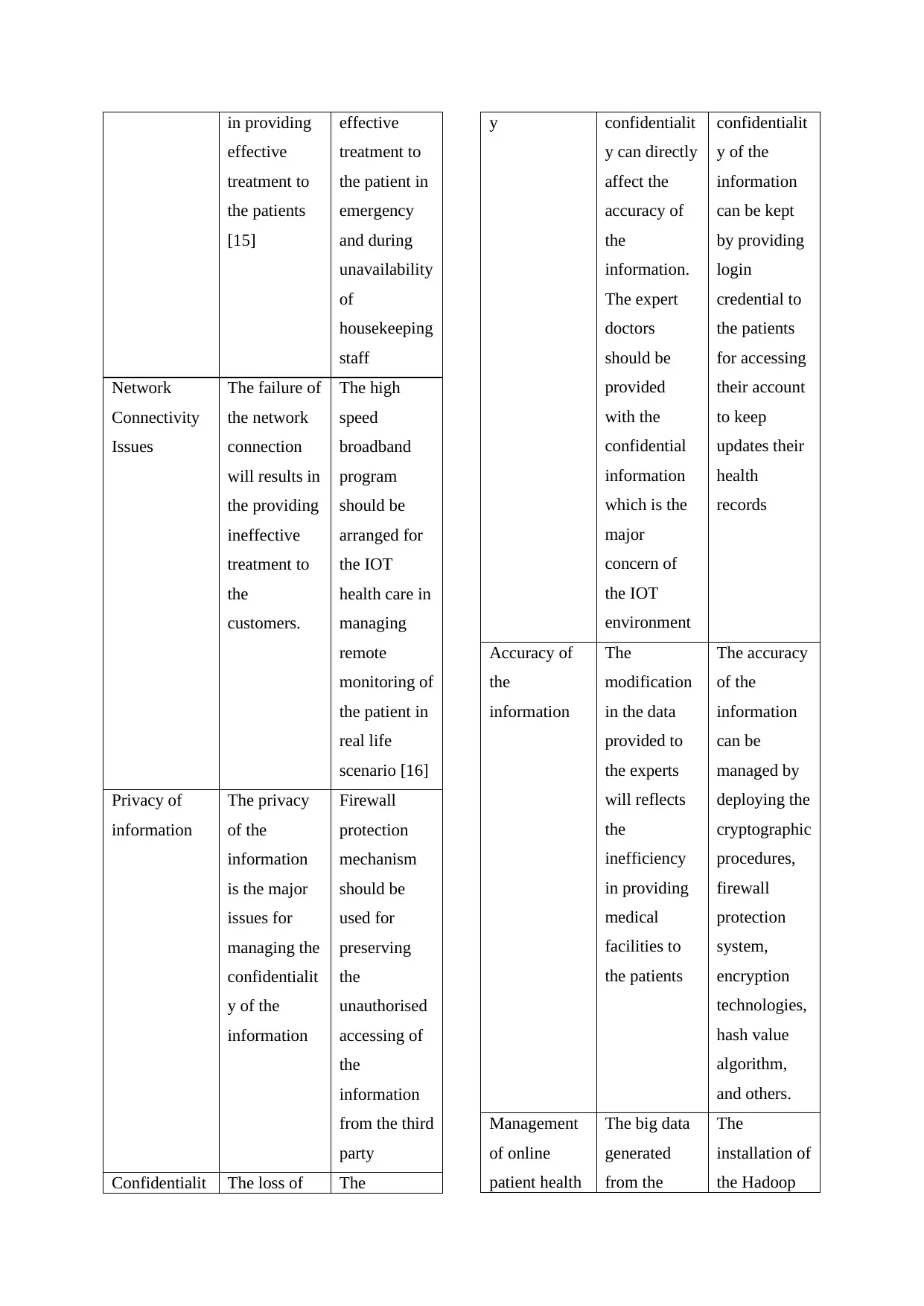
in providing
effective
treatment to
the patients
[15]
effective
treatment to
the patient in
emergency
and during
unavailability
of
housekeeping
staff
Network
Connectivity
Issues
The failure of
the network
connection
will results in
the providing
ineffective
treatment to
the
customers.
The high
speed
broadband
program
should be
arranged for
the IOT
health care in
managing
remote
monitoring of
the patient in
real life
scenario [16]
Privacy of
information
The privacy
of the
information
is the major
issues for
managing the
confidentialit
y of the
information
Firewall
protection
mechanism
should be
used for
preserving
the
unauthorised
accessing of
the
information
from the third
party
Confidentialit The loss of The
y confidentialit
y can directly
affect the
accuracy of
the
information.
The expert
doctors
should be
provided
with the
confidential
information
which is the
major
concern of
the IOT
environment
confidentialit
y of the
information
can be kept
by providing
login
credential to
the patients
for accessing
their account
to keep
updates their
health
records
Accuracy of
the
information
The
modification
in the data
provided to
the experts
will reflects
the
inefficiency
in providing
medical
facilities to
the patients
The accuracy
of the
information
can be
managed by
deploying the
cryptographic
procedures,
firewall
protection
system,
encryption
technologies,
hash value
algorithm,
and others.
Management
of online
patient health
The big data
generated
from the
The
installation of
the Hadoop
effective
treatment to
the patients
[15]
effective
treatment to
the patient in
emergency
and during
unavailability
of
housekeeping
staff
Network
Connectivity
Issues
The failure of
the network
connection
will results in
the providing
ineffective
treatment to
the
customers.
The high
speed
broadband
program
should be
arranged for
the IOT
health care in
managing
remote
monitoring of
the patient in
real life
scenario [16]
Privacy of
information
The privacy
of the
information
is the major
issues for
managing the
confidentialit
y of the
information
Firewall
protection
mechanism
should be
used for
preserving
the
unauthorised
accessing of
the
information
from the third
party
Confidentialit The loss of The
y confidentialit
y can directly
affect the
accuracy of
the
information.
The expert
doctors
should be
provided
with the
confidential
information
which is the
major
concern of
the IOT
environment
confidentialit
y of the
information
can be kept
by providing
login
credential to
the patients
for accessing
their account
to keep
updates their
health
records
Accuracy of
the
information
The
modification
in the data
provided to
the experts
will reflects
the
inefficiency
in providing
medical
facilities to
the patients
The accuracy
of the
information
can be
managed by
deploying the
cryptographic
procedures,
firewall
protection
system,
encryption
technologies,
hash value
algorithm,
and others.
Management
of online
patient health
The big data
generated
from the
The
installation of
the Hadoop
Paraphrase This Document
Need a fresh take? Get an instant paraphrase of this document with our AI Paraphraser
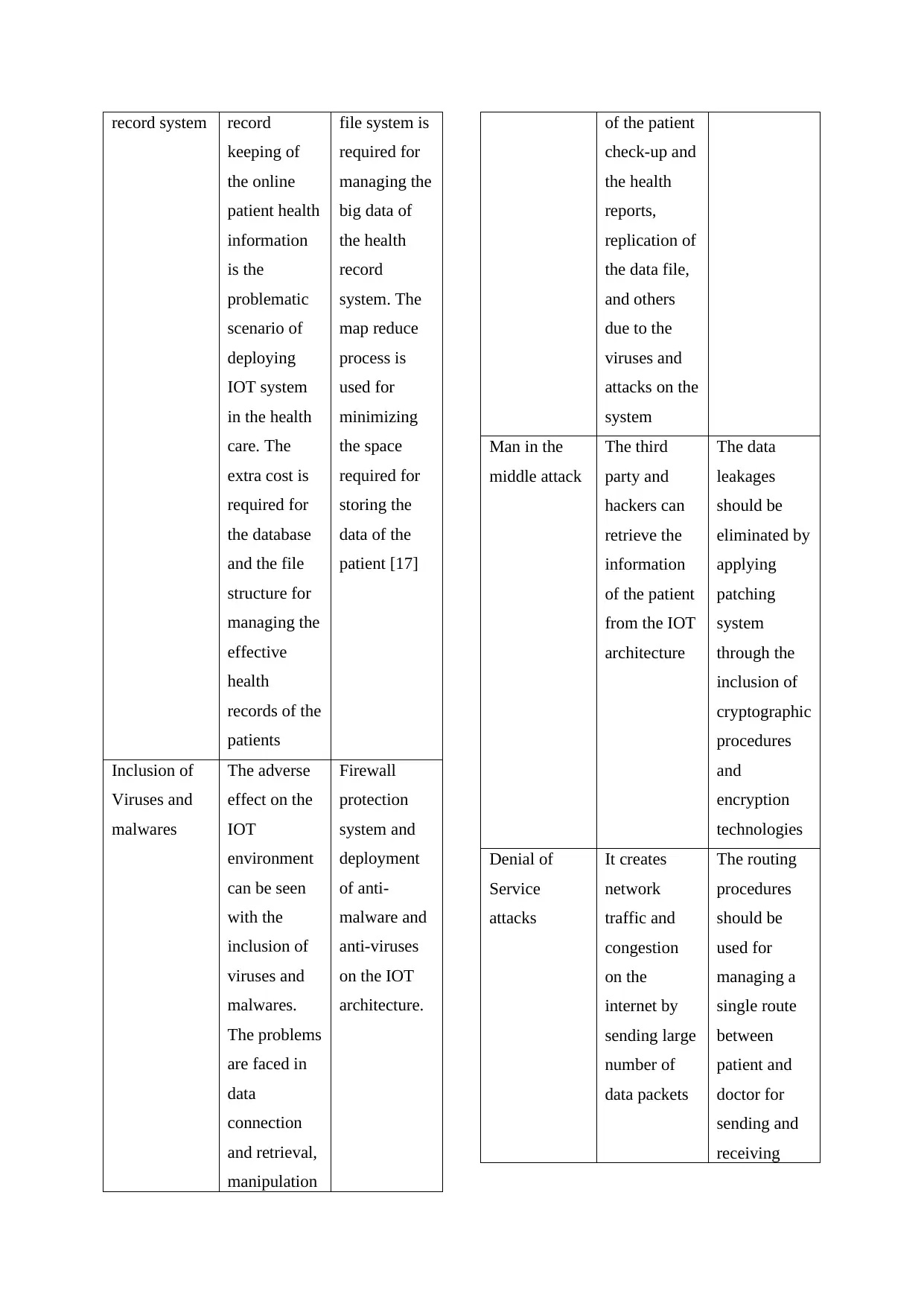
record system record
keeping of
the online
patient health
information
is the
problematic
scenario of
deploying
IOT system
in the health
care. The
extra cost is
required for
the database
and the file
structure for
managing the
effective
health
records of the
patients
file system is
required for
managing the
big data of
the health
record
system. The
map reduce
process is
used for
minimizing
the space
required for
storing the
data of the
patient [17]
Inclusion of
Viruses and
malwares
The adverse
effect on the
IOT
environment
can be seen
with the
inclusion of
viruses and
malwares.
The problems
are faced in
data
connection
and retrieval,
manipulation
Firewall
protection
system and
deployment
of anti-
malware and
anti-viruses
on the IOT
architecture.
of the patient
check-up and
the health
reports,
replication of
the data file,
and others
due to the
viruses and
attacks on the
system
Man in the
middle attack
The third
party and
hackers can
retrieve the
information
of the patient
from the IOT
architecture
The data
leakages
should be
eliminated by
applying
patching
system
through the
inclusion of
cryptographic
procedures
and
encryption
technologies
Denial of
Service
attacks
It creates
network
traffic and
congestion
on the
internet by
sending large
number of
data packets
The routing
procedures
should be
used for
managing a
single route
between
patient and
doctor for
sending and
receiving
keeping of
the online
patient health
information
is the
problematic
scenario of
deploying
IOT system
in the health
care. The
extra cost is
required for
the database
and the file
structure for
managing the
effective
health
records of the
patients
file system is
required for
managing the
big data of
the health
record
system. The
map reduce
process is
used for
minimizing
the space
required for
storing the
data of the
patient [17]
Inclusion of
Viruses and
malwares
The adverse
effect on the
IOT
environment
can be seen
with the
inclusion of
viruses and
malwares.
The problems
are faced in
data
connection
and retrieval,
manipulation
Firewall
protection
system and
deployment
of anti-
malware and
anti-viruses
on the IOT
architecture.
of the patient
check-up and
the health
reports,
replication of
the data file,
and others
due to the
viruses and
attacks on the
system
Man in the
middle attack
The third
party and
hackers can
retrieve the
information
of the patient
from the IOT
architecture
The data
leakages
should be
eliminated by
applying
patching
system
through the
inclusion of
cryptographic
procedures
and
encryption
technologies
Denial of
Service
attacks
It creates
network
traffic and
congestion
on the
internet by
sending large
number of
data packets
The routing
procedures
should be
used for
managing a
single route
between
patient and
doctor for
sending and
receiving
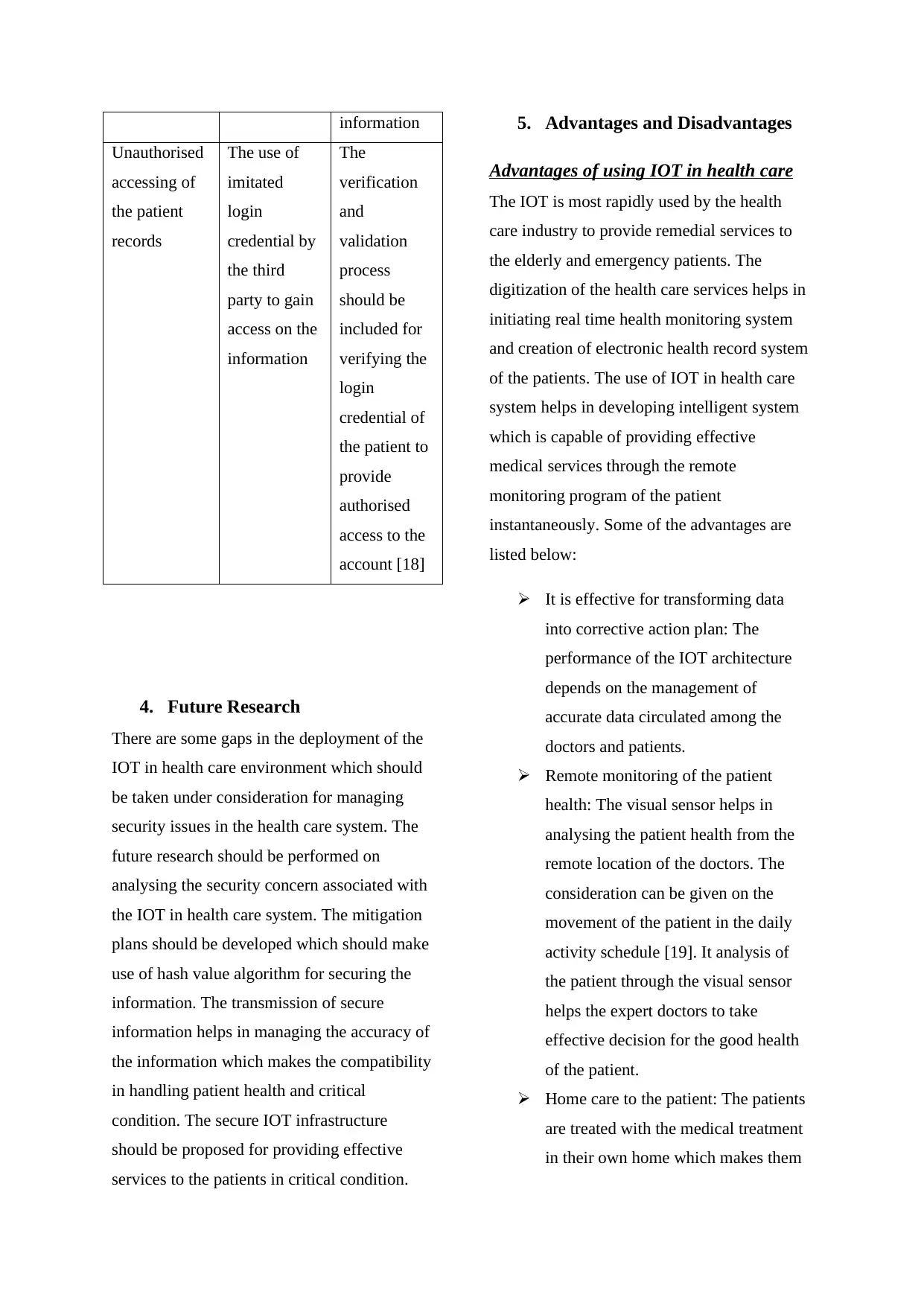
information
Unauthorised
accessing of
the patient
records
The use of
imitated
login
credential by
the third
party to gain
access on the
information
The
verification
and
validation
process
should be
included for
verifying the
login
credential of
the patient to
provide
authorised
access to the
account [18]
4. Future Research
There are some gaps in the deployment of the
IOT in health care environment which should
be taken under consideration for managing
security issues in the health care system. The
future research should be performed on
analysing the security concern associated with
the IOT in health care system. The mitigation
plans should be developed which should make
use of hash value algorithm for securing the
information. The transmission of secure
information helps in managing the accuracy of
the information which makes the compatibility
in handling patient health and critical
condition. The secure IOT infrastructure
should be proposed for providing effective
services to the patients in critical condition.
5. Advantages and Disadvantages
Advantages of using IOT in health care
The IOT is most rapidly used by the health
care industry to provide remedial services to
the elderly and emergency patients. The
digitization of the health care services helps in
initiating real time health monitoring system
and creation of electronic health record system
of the patients. The use of IOT in health care
system helps in developing intelligent system
which is capable of providing effective
medical services through the remote
monitoring program of the patient
instantaneously. Some of the advantages are
listed below:
It is effective for transforming data
into corrective action plan: The
performance of the IOT architecture
depends on the management of
accurate data circulated among the
doctors and patients.
Remote monitoring of the patient
health: The visual sensor helps in
analysing the patient health from the
remote location of the doctors. The
consideration can be given on the
movement of the patient in the daily
activity schedule [19]. It analysis of
the patient through the visual sensor
helps the expert doctors to take
effective decision for the good health
of the patient.
Home care to the patient: The patients
are treated with the medical treatment
in their own home which makes them
Unauthorised
accessing of
the patient
records
The use of
imitated
login
credential by
the third
party to gain
access on the
information
The
verification
and
validation
process
should be
included for
verifying the
login
credential of
the patient to
provide
authorised
access to the
account [18]
4. Future Research
There are some gaps in the deployment of the
IOT in health care environment which should
be taken under consideration for managing
security issues in the health care system. The
future research should be performed on
analysing the security concern associated with
the IOT in health care system. The mitigation
plans should be developed which should make
use of hash value algorithm for securing the
information. The transmission of secure
information helps in managing the accuracy of
the information which makes the compatibility
in handling patient health and critical
condition. The secure IOT infrastructure
should be proposed for providing effective
services to the patients in critical condition.
5. Advantages and Disadvantages
Advantages of using IOT in health care
The IOT is most rapidly used by the health
care industry to provide remedial services to
the elderly and emergency patients. The
digitization of the health care services helps in
initiating real time health monitoring system
and creation of electronic health record system
of the patients. The use of IOT in health care
system helps in developing intelligent system
which is capable of providing effective
medical services through the remote
monitoring program of the patient
instantaneously. Some of the advantages are
listed below:
It is effective for transforming data
into corrective action plan: The
performance of the IOT architecture
depends on the management of
accurate data circulated among the
doctors and patients.
Remote monitoring of the patient
health: The visual sensor helps in
analysing the patient health from the
remote location of the doctors. The
consideration can be given on the
movement of the patient in the daily
activity schedule [19]. It analysis of
the patient through the visual sensor
helps the expert doctors to take
effective decision for the good health
of the patient.
Home care to the patient: The patients
are treated with the medical treatment
in their own home which makes them
⊘ This is a preview!⊘
Do you want full access?
Subscribe today to unlock all pages.

Trusted by 1+ million students worldwide
1 out of 15
Related Documents
Your All-in-One AI-Powered Toolkit for Academic Success.
+13062052269
info@desklib.com
Available 24*7 on WhatsApp / Email
![[object Object]](/_next/static/media/star-bottom.7253800d.svg)
Unlock your academic potential
Copyright © 2020–2025 A2Z Services. All Rights Reserved. Developed and managed by ZUCOL.




